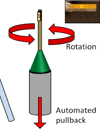Adaptive windowing in contrast-enhanced intravascular ultrasound imaging
- PMID: 27161022
- PMCID: PMC4899141
- DOI: 10.1016/j.ultras.2016.04.022
Adaptive windowing in contrast-enhanced intravascular ultrasound imaging
Abstract
Intravascular ultrasound (IVUS) is one of the most commonly-used interventional imaging techniques and has seen recent innovations which attempt to characterize the risk posed by atherosclerotic plaques. One such development is the use of microbubble contrast agents to image vasa vasorum, fine vessels which supply oxygen and nutrients to the walls of coronary arteries and typically have diameters less than 200μm. The degree of vasa vasorum neovascularization within plaques is positively correlated with plaque vulnerability. Having recently presented a prototype dual-frequency transducer for contrast agent-specific intravascular imaging, here we describe signal processing approaches based on minimum variance (MV) beamforming and the phase coherence factor (PCF) for improving the spatial resolution and contrast-to-tissue ratio (CTR) in IVUS imaging. These approaches are examined through simulations, phantom studies, ex vivo studies in porcine arteries, and in vivo studies in chicken embryos. In phantom studies, PCF processing improved CTR by a mean of 4.2dB, while combined MV and PCF processing improved spatial resolution by 41.7%. Improvements of 2.2dB in CTR and 37.2% in resolution were observed in vivo. Applying these processing strategies can enhance image quality in conventional B-mode IVUS or in contrast-enhanced IVUS, where signal-to-noise ratio is relatively low and resolution is at a premium.
Keywords: Adaptive beamforming; Contrast-enhanced ultrasound; High frequency ultrasound; Intravascular ultrasound; Phase coherence factor; Superharmonic.
Copyright © 2016 Elsevier B.V. All rights reserved.
Figures










References
-
- World Health Organization. Fact sheet no. 310: The top 10 causes of death. 2014 May; 2014.
-
- Mintz GS, Nissen SE, Anderson WD, Bailey SR, Erbel R, Fitzgerald PJ, et al. American College of Cardiology Clinical Expert Consensus Document on Standards for Acquisition, Measurement and Reporting of Intravascular Ultrasound Studies (IVUS). A report of the American College of Cardiology Task Force on Clinical Expert Consensus Documents. J Am Coll Cardiol. 2001 Apr;37:1478–1492. - PubMed
-
- Maehara A, Mintz GS, Weissman NJ. Advances in intravascular imaging. Circ Cardiovasc Interv. 2009 Oct;2:482–490. - PubMed
-
- Falk E. Why Do Plaques Rupture. Circulation. 1992 Dec;86:30–42. - PubMed
-
- Finn AV, Nakano M, Narula J, Kolodgie FD, Virmani R. Concept of vulnerable/unstable plaque. Arterioscler Thromb Vasc Biol. 2010 Jul;30:1282–1292. - PubMed
Publication types
MeSH terms
Substances
Grants and funding
LinkOut - more resources
Full Text Sources
Other Literature Sources
Medical

